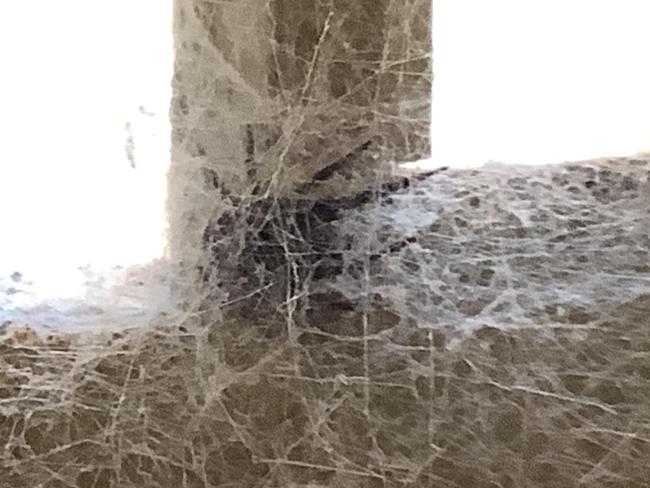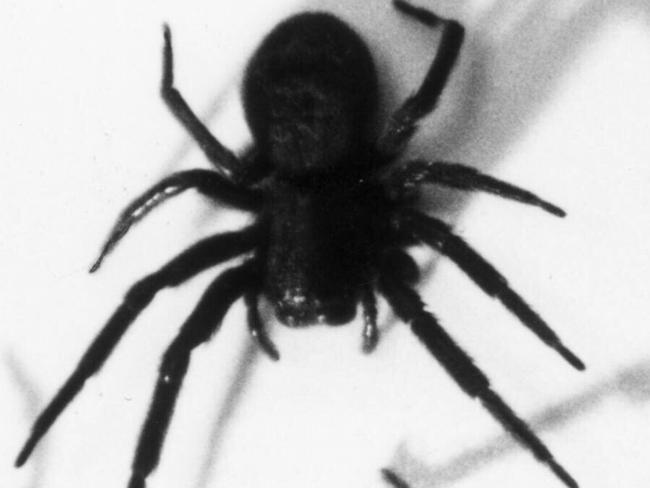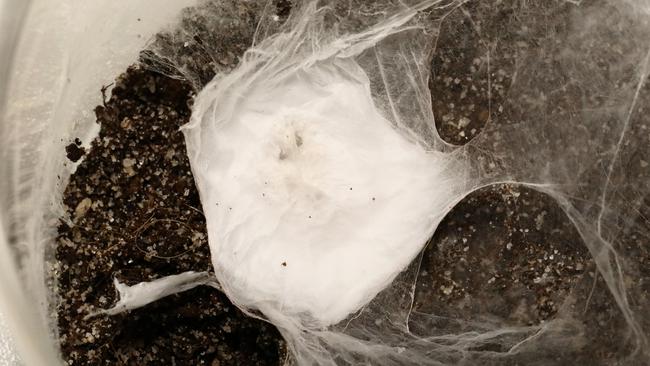Geelong man says same big black house spider has lived in his window for nine years
A Geelong man’s claim that a big spider has lived in his window for nine years — having multiple “litters” — has split the web, with some saying they let spiders live in their cars and bathrooms.

Victoria
Don't miss out on the headlines from Victoria. Followed categories will be added to My News.
A Victorian man claims to have kept the same big, black house spider in a window for nearly a decade.
Aaron Johnston posted on a Geelong community page recently the large female spider had “lived in my window for nine years”, adding that during that time she “had five litters … everyone was moved as needed. Life!”
The post — complete with photos of the spider and her home — generated scores of comments, with many people questioning if he could be sure it was the same spider.
Mr Johnston said he was confident it was, and that he moved into the house in 2014 and the spider, who he had named scaredy-cat, had appeared in 2015.
“She loves blowflies! And she has shedded her skin six or so times, and has not moved from that spot (in the window) since,” he said.


According to Australian Museum, the typical lifespan of a black house spider in the wild is about two years.
While surprised at the claimed long life of scaredy-cat, a number of people commented that they had lived with the same black house spider for four or five years, with one woman lamenting the recent passing of her long-lived spider companion, Betty.
Another woman said a spider had lived in her “car mirror building hut” for the past six months and she thought it was “cute”, so let it be.
“We let spiders live in our bathroom, one I even have named,” she said, leading to a comment from another woman that it was “disgusting”.
Yet others said “there is only one good spider — a dead one”, and that Mr Johnston should get out the Mortein.
However, many others remarked that having a “natural insect catcher” in the house was an advantage.
Some people even purchase black house spiders as pets, with website Mypets stating females can lay up to 100 eggs.

“The Australian black house spider is a popular pet choice for many Australian households. These spiders are relatively easy to care for, and can provide a unique and interesting pet experience,” the website notes.
“The first benefit of keeping Australian black house spiders as pets is that they are relatively low-maintenance … another benefit of keeping Australian black house spiders is that they can be very entertaining. These spiders are quite curious and can often be seen exploring their environment. They can also be trained to respond to certain stimuli, such as a light or sound. This makes them a great choice for those looking for an interactive pet experience … with the proper care, the spider can live for several years in a safe and happy environment.”
The website adds Australian black house spiders shed their skin approximately once a month as they grow and “it is important to provide them with a small hiding spot where they can moult in private”.
ALL ABOUT BLACK HOUSE SPIDERS
What do they look like?
According to Australian Museum, the black house spider (Badumna insignis) belongs to the spider family desidae, and related species are found throughout the country.
A dark, robust spider, with grey hairs visible on its carapace, females of the species are larger than males but there is a great range in adult sizes.
“The carapace and legs are dark brown to black, and the abdomen is charcoal grey with a dorsal pattern of white markings (sometimes indistinct),” Australian Museum says.
Their webs
“The web structure includes one or more ‘funnel-like’ entrances to the spider’s retreat, which is sometimes misunderstood as a funnel-web spider web. However, black house spiders are not at all related to Australian funnel-webs, nor similar in appearance, size or life history,” Australian Museum informs.
Also unlike the funnel-web, which often has a burrow in the ground or in tree trunk crevices, the silk of house spider webs is exposed.

Black house spiders can be found on tree trunks, logs, rock walls and buildings — typically in window frames and wall crevices — and are widely distributed across the country, particularly concentrated in southern and eastern Australia.
The webs of black house spiders are constructed from cribellate silk, which is not sticky but is made from multiple combed fine strands and is extremely efficient at snagging the spiny legs of insects. The webs are in the form of lacy silk sheets, which spread out around one or more entrances to the spider’s retreat. New silk is fine and laid in a distinctive zigzag pattern, but old sheets become matted and untidy. New silk is mostly laid at night.
Diet
In the bush, Badumna insignis is found especially upon rough-barked trees which provide good shelter for their retreats among the cracks in the bark. Trees that have been attacked by wood-boring insects are particularly attractive, as the sap flowing from the bored holes attracts potential prey such as flies, beetles, butterflies and bees, which may become snagged in the fine edges of the web. Around houses, black house spiders feed upon insects such as moths, beetles and termites which are attracted to the light of windows and lamps at night.
Life history cycle
The female constructs several white silk egg sacs, which are secured within the web retreat. The female stays with the eggs until they hatch. The spiderlings then disperse. The spiders mature during summertime and typically live for about two years.
Breeding behaviours
The female spider never leaves her web unless forced to, but keeps on adding new layers – old webs can look grey and woolly from constant additions of silk. Males, when ready to mate, go in search of females in their webs. The male plucks the web of the female to attract her attention. Once the male has made sure that the female will be receptive, he can safely approach and inseminate her with sperm stored in his palps. They may then stay together for several days and may mate again several times. If a small male is caught in a female’s retreat when a larger male enters he can be severely injured and lose several legs.
Predators
Enemies of the black house spider include the white-tailed spider, as well as parasitic wasps and flies.
Are black house spiders dangerous?
Black House Spiders are timid animals and bites from them are infrequent. The bite may be quite painful and cause local swelling. Symptoms such as nausea, vomiting, sweating and giddiness are occasionally recorded. In a few cases skin lesions have developed after multiple bites.
(Source: Australian Museum)
More Coverage
Originally published as Geelong man says same big black house spider has lived in his window for nine years




